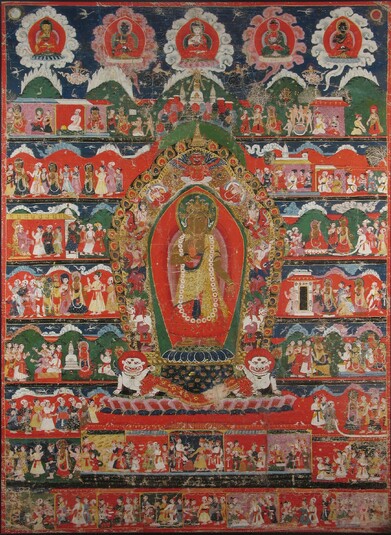
Item: Dipamkara Buddha - (Standing)
| Origin Location | Nepal |
|---|---|
| Date Range | 1700 - 1799 |
| Lineages | Buddhist |
| Material | Ground Mineral Pigment on Cotton |
| Collection | Rubin Museum of Art |
Classification: Deity
Appearance: Buddha
Gender: Male
Dipamkara Buddha with Kathmandu narrative scenes and the Swayambhunatha Stupa above the central figure. A slightly obscured inscription gives the date as either 1652 or 1752 C.E.
Dipamkara is the Buddha of the previous age prior to the time of Shakyamuni - the historical Buddha. Dipamkara is especially remembered as the Buddha that predicted the future enlightenment of the historical Buddha (6th century B.C.). In approximately the 17th century his rituals were popularized by Nepalese Buddhists who considered him a patron deity for merchants and alms-giving. During special alms giving festivals a painting such as this would be commissioned and displayed. The location of the festival illustrated in the painting is the Swayambhunath Stupa of Kathmandu. The stupa is depicted above the central figure. Accompanying depictions of the patrons of the painting appear in the lower registers. Dipamkara is popularly worshiped in Nepal but rarely found in other parts of the Himalayas, Tibet, or surrounding regions.
The subject of the painting is important for the Newar Buddhists of the Kathmandu Valley although little has been written on this subject in English. The painting is dated and the donors of the painting are listed in the registers.
Painted during the Shah period this paubha (scroll painting) is a good example of the development of later Newar work. The sophistication of Malla period art is clearly missing and is replaced by more lively scenes of donors and festivals. A classic element of later period painting is the introduction of Tibetan style cloud work often supporting the Five Transcendent Buddhas (as seen in the top register of this painting). The introduction of landscape and natural elements becomes more common during the Shah period. The squared off stance of the central figure and stiff pose are also common traits found in Shah period art. Although slightly comical and without any sense of perspective or depth, the rolling hills, swooping birds, and snow capped peaks add a certain Nepali charm to this late painting.
Jeff Watt & David Pritzker 2-2008
Collection of Rubin Museum of Art: Nepal
Buddhist Deity: Dipamkara Buddha
Collection: Christie's, Painting (Sept, 1998; NY)
Subject: Five Buddhas (Secondary Figures)


